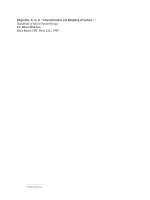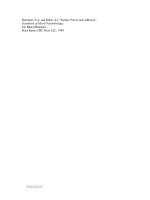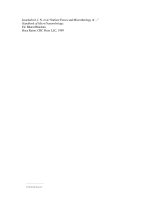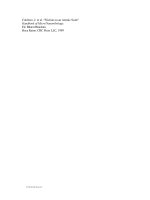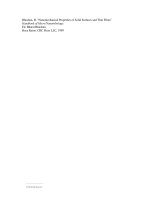handbook of chemical and environmental engineering calculations
Bạn đang xem bản rút gọn của tài liệu. Xem và tải ngay bản đầy đủ của tài liệu tại đây (26.7 MB, 960 trang )
HANDBOOK OF CHEMICAL
AND ENVIRONMENTAL
ENGINEERING
CALCULATIONS
Joseph P. Reynolds
John S. Jeris
Louis Theodore
WILEY-
INTERSCIENCE
A John Wiley & Sons, Inc., Publication
Copyrighted Material
Copyright © 2002 John Wiley & Sons Retrieved from: www.knovel.com
This book is printed on acid-free paper. (S)
Copyright © 2002 by John Wiley & Sons, Inc., New York. All rights reserved.
Published simultaneously in Canada.
No part of this publication may be reproduced, stored in a retrieval system or transmitted in any form or by
any means, electronic, mechanical, photocopying, recording, scanning or otherwise, except as permitted
under Sections 107 or 108 of the 1976 United States Copyright Act, without either the prior written
permission of the Publisher, or authorization through payment of the appropriate per-copy fee to the
Copyright Clearance Center, 222 Rosewood Drive, Danvers, MA 01923, (978) 750-8400, fax (978) 750-
4744.
Requests to the Publisher for permission should be addressed to the Permissions Department, John
Wiley & Sons, Inc., 605 Third Avenue, New York, NY 10158-0012, (212) 850-6011, fax (212) 850-6008,
E-Mail:
For ordering and customer service information please call 1-800-CALL-WILEY.
Library of Congress Cataloging-in-Publication Data is available.
ISBN 0-471-40228-1
Printed in the United States of America.
10 987654321
Copyrighted Material
Copyright © 2002 John Wiley & Sons Retrieved from: www.knovel.com
To Barbara, Megan, and Marybeth
for their unrelenting support, good-natured criticism,
and putting up with their husband and father [J.P.R.]
To my lovely wife Helen,
who for years endured neglect as I followed the path of
professional growth but still found it possible to
offer her strong support and love [J.S.J]
To Brother Conrad Timothy Burris, ES. C,
Professor Emeritus of Chemical Engineering and
Former Dean of Engineering at Manhattan College
for having the foresight to allow the School of Engineering to
achieve its potential during his tenure as dean,
for providing the leadership necessary for the school to reach its
potential, and for hiring me in 1960 [L. T]
Copyrighted Material
Copyright © 2002 John Wiley & Sons Retrieved from: www.knovel.com
PREFACE
Because of the pervasive nature of environmental problems, the overlap and
interrelationship between the chemical and environmental engineering disciplines
have become unavoidable. Further, many have agreed that environmental engineer-
ing involves the application of chemical engineering fundamentals and principles to
the environment.
From an academic perspective, environmental engineering programs have tradi-
tionally been offered at the graduate level. More recently, formal environmental
engineering programs—with the accompanying degree—are being offered at the
undergraduate level. As a result, courses similar in content are often offered in both
programs. This recent phenomenon has created a need for the development of
material concerned with both chemical and environmental engineering calculations.
The resulting end product is the Handbook of Chemical and Environmental
Engineering Calculations.
As is usually the case in preparing any text, the question of what to include and
what to omit has been particularly difficult. However, the problems and solutions in
the Handbook attempt to address calculations common to both chemical and
environmental engineering. This Handbook provides the reader with nearly 600
solved problems in the chemical and environmental engineering fields. Of the eight
parts,
two are concerned with chemical engineering and six with environmental
engineering. The interrelationship between both fields is emphasized in all parts.
Each part is divided into a number of problem sets, each set containing anywhere
from 8 to 12 problems and solutions.
This project was a unique undertaking. Rather than prepare a textbook in the
usual format—essay material, illustrative examples, nomenclature, bibliography,
problems, etc.,—the authors considered writing a calculations handbook that
could be used as a self-teaching aid. One of the key features of this book is that
the solutions to the problems are presented in a stand-alone manner. Throughout the
book, the problems are laid out in such a way as to develop the reader's technical
understanding of the subject in question. Each problem contains a title, problem
statement, and data and solution, with the more difficult problems located at or near
the end of each problem set. Thus, this Handbook offers material not only to
individuals with limited technical background but also to those with extensive
industrial experience. As such, this Handbook can be used as a text in either a
general chemical engineering or environmental engineering course and (perhaps
primarily) as a training tool for industry.
Copyrighted Material
Copyright © 2002 John Wiley & Sons Retrieved from: www.knovel.com
The authors cannot claim sole authorship to all the problems and material in this
Handbook. The present book has evolved from a host of sources including: exam
problem prepared by Dr. Sum Marie Flynn for her undergraduate Process Control
course; notes, homework problems and exam problems prepared by J. Jeris for
graduate environmental engineering courses; notes, homework problems, and exam
problems prepared by L. Theodore for several chemical and environmental engi-
neering graduate and undergraduate courses; problems and solutions drawn (with
permission) from numerous Theodore Tutorials; and problems and solutions devel-
oped by faculty participants during National Science Foundation (NSF) Under-
graduate Faculty Enhancement Program (UFEP) workshops.
One of the objectives of the NSF workshops included the development of
illustrative examples by the faculty. Approximately 40 out of the nearly 600
problems provided in this Handbook were drawn, in part, from the original work
of these faculty. We would like to acknowledge the following professors whose
problems, in original or edited form, are included on this Handbook. (The problem
numbers are noted in parenthesis alongside each name.)
Prof.
William Auberle; Civil and Environmental Engineering, Northern Arizona
University (ENCl, ULT.4)
Dr. Howard Bein; Chemistry, U.S. Merchant Marine Academy, (ISO.2, ISO.3)
Dr. Seymour Block; Chemical Engineering, University of Florida (MED. 8)
Dr. Ihab Farag; Chemical Engineering, University of New Hampshire (MED.9)
Dr. Kumar Ganesan; Environmental Engineering, Montana Tech of the University
of Montana (ISO.6, IAQ.4, IAQ.5, IAQ.6)
Dr. David James; Civil and Environmental Engineering, University of Nevada at
Las Vegas (HZA.2, ENC.4, ULT.5)
Dr. Christopher Koroneos; Chemical Engineering, Columbia University (ECO.2,
ECO.4, ECO.5, ECO.8)
Dr. SoonSik Lim; Chemical Engineering, Youngstown State University (CHR. 7)
Dr. Sean X. Liu; Civil and Environmental Engineering, University of California
at Berkley (ULT.6, ECO.6, MUN.5, MUN.6, MED.6)
Dr. P.M. Lutchmansingh; Petroleum Engineering, Montana Tech of the University
of Montana (ECO.7)
Dr. Suwanchai Nitisoravut; Civil Engineering, University of North Carolina at
Charlotte (ULT.7, ISO.5, CHR.5)
Dr. Holly Peterson; Environmental Engineering, Montana Tech of the University
of Montana (IAQ. 1)
Dr. Lisa Reidl; Civil Engineering, University of Wisconsin at Platteville (RCY.7)
Dr. Carol Reifschneider; Science and Math, Montana State University (ISO.4)
Dr. Dennis Ryan; Chemistry, Hofstra University, (CHR. 6)
Dr. Dilip K. Singh; Chemical Engineering, Youngstown University (ENClO)
Copyrighted Material
Copyright © 2002 John Wiley & Sons Retrieved from: www.knovel.com
Dr. David Stevens, Civil and Environmental Engineering, Utah State University
(HRA.4, WQA. 10)
Dr. Bruce Thomson; Civil Engineering, University of New Mexico (CHR.8)
Dr. Frank Worley; Chemical Engineering, University of Houston
(MED.
7)
Dr. Ronald Wukash; Civil Engineering, Purdue University (MED. 10)
Dr. Poa-Chiang (PC) Yuan; Civil Engineering, Jackson State University (ISO.l,
MUN.7,
MUN.8, HRA. 1, HRA.2)
During the preparation of this Handbook, the authors were ably assisted in many
ways by a number of graduate students in Manhattan College's Chemical Engineer-
ing Master's Program. These students contributed much time and energy researching
and classroom testing various problems in the book.
Two other sources that were employed in preparing the problems included
numerous Theodore Tutorials (plus those concerned with the professional engineer-
ing exam) and the Wilcox and Theodore 1999 Wiley-Interscience text, Engineering
and Environmental Ethics. Finally, the authors wish to acknowledge the National
Science Foundation for supporting several faculty workshops (described above) that
produced a number of problems appearing in this Handbook.
Somehow the editor usually escapes acknowledgment. We were particularly
fortunate to have Bob Esposito ("Espo" to us) of John Wiley & Sons serve as
our editor. He had the vision early on to realize the present need and timeliness for a
handbook of this nature.
Joseph P. Reynolds
John S. Jeris
Louis Theodore
Copyrighted Material
Copyright © 2002 John Wiley & Sons Retrieved from: www.knovel.com
vii
This page has been reformatted by Knovel to provide easier navigation.
Contents
Preface xi
Part 1. Chemical Engineering Fundamentals 1
1. Units and Dimensions (UAD) 3
2. Conservation Law for Mass (CMA) 14
3. Conservation Law for Energy (CLE) 28
4. Conservation Law for Momentum (CLM) 43
5. Stoichiometry (STO) 58
Part 2. Chemical Engineering Principles 73
6. Fluid Flow (FFL) 75
7. Heat Transfer (HTR) 92
8. Mass Transfer Operations (MTO) 108
9. Thermodynamics (THR) 147
10. Chemical Kinetics (KIN) 171
11. Process Control (CTR) 204
12. Process Design (PRD) 242
Part 3. Air Pollution Control Equipment 265
13. Fluid Particle Dynamics (FPD) 267
14. Mechanical Collectors (MCC) 284
15. Electrostatic Precipitators (ESP) 306
16. Baghouse (BAG) 323
17. Venturi Scrubbers (VEN) 341
18. Hybrid Systems (HYB) 359
Copyrighted Material
Copyright © 2002 John Wiley & Sons Retrieved from: www.knovel.com
viii Contents
This page has been reformatted by Knovel to provide easier navigation.
19. Combustion (CMB) 371
20. Absorption (ABS) 392
21. Adsorption (ADS) 414
Part 4. Solid Waste 439
22. Regulations (REG) 441
23. Characteristics (CHR) 456
24. Nuclear/Radioactive Waste (NUC) 464
25. Superfund (SUP) 475
26. Municipal Waste (MUN) 487
27. Hazardous Waste Incineration (HWI) 505
28. Hospital/Medical Waste (MED) 521
Part 5. Water Quality and Wastewater Treatment 537
29. Regulations (REG) 539
30. Characteristics (CHR) 548
31. Water Chemistry (WCH) 562
32. Physical Treatment (PHY) 574
33. Biological Treatment (BIO) 592
34. Chemical Treatment (CHM) 616
35. Sludge Handling (SLU) 631
36. Water Quality Analysis (WQA) 640
Part 6. Pollution Prevention 657
37. Source Reduction (RED) 659
38. Recycle/Reuse (RCY) 680
39. Treatment (TRT) 694
40. Ultimate Disposal (ULT) 706
41. Energy Conservation (ENC) 718
42. Domestic Applications (DOM) 733
Copyrighted Material
Copyright © 2002 John Wiley & Sons Retrieved from: www.knovel.com
Contents ix
This page has been reformatted by Knovel to provide easier navigation.
Part 7. Health, Safety, and Accident Management 743
43. Toxicology (TOX) 745
44. Health Risk Analysis (HRA) 758
45. Hazard Risk Analysis (HZA) 776
46. Hazard Risk Assessment (HZR) 800
47. Industrial Applications (IAP) 817
Part 8. Other Topics 835
48. Dispersion (DSP) 837
49. Noise Pollution (NOP) 858
50. Economics (ECO) 867
51. Ethics (ETH) 883
52. Statistics (STT) 902
53. Indoor Air Quality (IAQ) 917
54. ISO 14000 (ISO) 923
55. Measurements (MEA) 928
Index 942
Copyrighted Material
Copyright © 2002 John Wiley & Sons Retrieved from: www.knovel.com
PART I
Chemical Engineering Fundamentals
Robert Ambrosini
1 Units and Dimensions (UAD)
2 Conservation Law for Mass (CMA)
3 Conservation Law for Energy (CLE)
4 Conservation Law for Momentum (CLM)
5 Stoichiometry (STO)
Copyrighted Material
Copyright © 2002 John Wiley & Sons Retrieved from: www.knovel.com
1 Units
and
Dimensions
(UAD)
UAD.l
UNIT CONVERSION
FACTORS
Convert
the
following:
1. 8.03
yr to
seconds
2. 150mile/h
to
yard/h
3.
100.0m/s
2
to
ft/min
2
4. 0.03 g/cm
3
to
lb/ft
3
Solution
1.
The
following conversion factors
are
needed:
365 day/yr
24h/day
60 min/h
60 s/min
Arranging
the
conversion factors
so
that units cancel
to
leave only
the
desired units,
the
following
is
obtained:
(8.03 yr)№) (™) (
6
^) (
6
^) = 2.53 x 10* s
V
y
r
/V
day/V
h
/\
mm
/
/150mile\/5280ft\/y
d
\
,
Jt
2. In similar fashion, ) ) ( — ) = 2.6 x 10
5
yd/h
\
h J\
mile
J\3ftJ
UAD.2 CHEMICAL CONVERSIONS
Answer
the
following:
1. What
is the
molecular weight
of
nitrobenzene (C
6
H
5
O
2
N)?
2. How many moles
are
there
in
50.0g
of
nitrobenzene?
Copyrighted Material
Copyright © 2002 John Wiley & Sons Retrieved from: www.knovel.com
3.
If the specific gravity of a substance is 1.203, what is the density in g/cm
3
?
4.
What is the volume occupied by 50.0g of nitrobenzene in cm
3
, in ft
3
, and in
in.
3
?
5.
If the nitrobenzene is held in a cylindrical container with a base of 1 in. in
diameter, what is the pressure at the base? What is it in gauge pressure?
6. How many molecules are contained in 50.0g of nitrobenzene?
Solution
1.
Pertinent atomic weights are listed below:
Carbon = 12
Hydrogen = 1
Oxygen =16
Nitrogen =14
The molecular weight of nitrobenzene is then
(6)(12) + (5)(1) + (2)(16) + (1)(14)
= 123g/gmol
2.
To convert a mass to moles, divide by the molecular weight:
(50
-
0g)
(^)
= 0
-
407gmo1
3.
Since specific gravity is a ratio of density to the density of water (1.000 g/cm
3
at 4
0
C),
P = (SG)(PH
2
O at 4°C)
= (1.203)(l-000 g/cm
3
) = 1.203 g/cm
3
4.
The results of part 3 may be employed to calculate the volume:
V=(
50
°
g
3
U 41.6cm
3
Vl.203 g/cm
3
;
Copyrighted Material
Copyright © 2002 John Wiley & Sons Retrieved from: www.knovel.com
Applying conversion factors,
(
-fi- \ ^
) - 1.46 x 10~
3
ft
3
30.48 cm/
= (1.46xl0-
3
ft
3
)(^V=2.52m.
3
5.
The cross-sectional area of the base is calculated as:
Since there are 454 g/lb,
50.Og = 0.1101b
Using Newton's law, the force exerted by the mass is
F = ml— J =(0.1101b)( 1^1 = 0.1101b
f
Note that, in the English system,
g = 32.2ft/s
2
Since the force is exerted over an area of 0.78 in.
2
, the pressure at the base is
F 0.1101b
f
P = - = 1 = 0.14psi
A 0.78 in.
2
By definition:
p
p p
gauge
absolute •* atmospheric
Thus,
^gauge = 0.14psi - 14.7 psi = -14.6psig
Copyrighted Material
Copyright © 2002 John Wiley & Sons Retrieved from: www.knovel.com
6. There are 6.02 x 10
23
(Avogadro's number) molecules/gmol. Therefore,
(0.406 gmol)(6.02 x 10
23
molecules/gmol) = 2.44 x 10
23
molecules
UAD.3 TEMPERATURE CONVERSIONS
Convert the following temperatures:
1.
20°Cto°F,K, and°R
2.
20
0
F to
0
C, K, and °R
Solution
The following key equations are employed:
J(
0
F) =
1.8J(
0
C)+
32
J (K) = J (
0
C) + 273
J (
0
R) = T (
0
F) + 460
J(
0
R)=
1.8J(K)
Thus,
1.
J (
0
F) =
1.8(20
0
C)
+ 32 = 68°F
J (K) = (20
0
C) + 273 = 293K
J(
0
R)=
1.8(293K)
= 527°R
2.
J (
0
C) = (20
0
F - 32)/1.8 = -6.7°C
J
(K)
= -6.7°C + 273 = 266K
J (
0
R) = 20
0
F + 460 = 480
0
R
UAD.4 PRESSURE CALCULATIONS
The height of a liquid column of mercury is 2.493 ft. Assume the density of mercury
is 848.7 lb/ft
3
and atmospheric pressure is 2116 lb
f
/ft
2
absolute. Calculate the gauge
pressure in lb
f
/ft
2
and the absolute pressure in lb
f
/ft
2
, psia, mm Hg, and in. H
2
O.
Solution
Expressed in various units, the standard atmosphere is equal to:
Copyrighted Material
Copyright © 2002 John Wiley & Sons Retrieved from: www.knovel.com
1.0 Atmospheres (atm)
33.91 Feet of water (ft H
2
O)
14.7 Pounds-force per square inch absolute (psia)
2116 Pounds-force per square foot absolute (psfa)
29.92 Inches of mercury (in. Hg)
760.0 Millimeters of mercury (mm Hg)
1.013 x 10
5
Newtons per square meter (N/m
2
)
The equation describing the gauge pressure in terms of the column height and liquid
density is
P
g
= Pgh/g
c
where P
g
= gauge pressure
p = liquid density
h = height of column
g = acceleration of gravity
g
c
= conversion constant
Thus,
p
g
= (848.7 lb/ft
3
)H ^ J(2.493 ft)
= 21161b
f
/ft
2
gauge
The pressure in lb
f
/ ft
2
absolute is
r
absolute
r
g ' -* atmospheric
= 21161b
f
/ft
2
+21161b
f
/ft
2
- 4232 lb
f
/ft
2
absolute
The pressure in psia is
P(psia) = (4232psfa)( A = 29.4 psia
\144in. /
The corresponding gauge pressure in psi is
P(psig) = 29.4 - 14.7 = 14.7 psig
Copyrighted Material
Copyright © 2002 John Wiley & Sons Retrieved from: www.knovel.com
The pressure in mm Hg is
P(mmHg) = (29.4psia)f
7
^^
mHg
) = 1520 mm Hg
\ 14.7 psia /
Note that 760 mm Hg is equal to 14.7 psia, which in turn is equal to 1.0 atm.
Finally, the pressure in in. H
2
O is
_/ 29.4psia \ /33.91 ftH
2
0\ /12in A
(inH20)
" Vl4.7psia/atm7
V
ato ) \fT)
= 813.8 in. H
2
O
The reader should note that absolute and gauge pressures are usually expressed with
units of atm, psi, or mm Hg. This statement also applies to partial pressures. One of
the most common units employed to describe pressure drop is inches of H
2
O, with
the notation in. H
2
O or IWC (inches of water column).
UAD.5 ENGINEERING CONVERSION FACTORS
Given the following data for liquid methanol, determine its density in lb/ft
3
and
convert heat capacity, thermal conductivity, and viscosity from the International
System of Units (SI) to English units:
Specific gravity = 0.92 (at 60
0
F)
Density of reference substance (water) = 62.4 lb/ft
3
(at 60
0
F)
Heat capacity = 0.61 cal/(g • °C) (at 60
0
F)
Thermal conductivity = 0.0512cal/(m • s •
0
C) (at 60
0
F)
Viscosity = 0.64 cP (at 60
0
F)
Solution
The definition of specific gravity for liquids and solids is
c r- •. Density
Specific gravity =
:
——
fc J
Density of water at 4° C
Note that the density of water at 4°C is 62.4 lb/ft
3
in English engineering units or
1.0g/cm
3
.
Copyrighted Material
Copyright © 2002 John Wiley & Sons Retrieved from: www.knovel.com
Calculate the density of methanol in English units by multiplying the specific
gravity by the density of water.
Density of methanol = (Specific gravity)(Density of water)
= (0.92)(62.4) = 57.41b/ft
3
The procedure is reversed if one is interested in calculating specific gravity from
density data. The notation for density is usually p.
Convert the heat capacity from units of cal/(g •
0
C) to Btu/(lb •
0
F).
/0.61 cal\ /454 g\ / Btu \ /
0
C \
r /u o x
(ir^-j
("ib
1
)
(252^1)
(LFF)
=
061 Btu/(lb
•
F)
Note that
1.0Btu/(lb
•
0
F) is equivalent to
1.0cal/(g
•
0
C). This also applies on a
mole basis, i.e.,
1 Btu/(lbmol •
0
F) = lcal/(gmol •
0
C)
The usual notation for heat capacity is C
p
. In this book, C
p
represents the heat
capacity on a mole basis, while c
p
indicates a mass basis.
Convert the thermal conductivity of methanol from cal/(m • s •
0
C) to
Btu/(ft • h •
0
F).
/0.0512cal\/ Btu \ /0.3048 m\ /3600 s\ / °C \
/£L t o x
The usual engineering notation for thermal conductivity is k.
Convert viscosity from centipoise to lb/( ft • s):
(0.64cP)f
6
-
72xl0
"
4lb
U4.3 x 10-
4
lb/(ft.s)
\ n • s • cP /
The notation for viscosity is typically \x. The kinematic viscosity, v, is defined by the
ratio of viscosity to density, i.e., v = \ijp with units of length /time.
Finally, note that the above physical properties are strong functions of the
temperature but weak functions of the pressure. Interestingly, the viscosity of a
gas increases with increasing temperature, while the viscosity of a liquid decreases
with an increase in temperature.
UAD.6 MOLAR RELATIONSHIPS
A mixture contains 20 Ib of O
2
, 2 Ib of SO
2
, and 3 Ib of SO
3
. Determine the weight
fraction and mole fraction of each component.
Copyrighted Material
Copyright © 2002 John Wiley & Sons Retrieved from: www.knovel.com
Solution
By definition:
Weight fraction = weight of A /total weight
Moles of A = weight of ,4/molecular weight of A
Mole fraction = moles of ,4/total moles
First, calculate the weight fraction of each component:
Compound Weight (Ib) Weight Fraction
O
2
20 20/25 = 0.8
50
2
2 0.08
50
3
_3 012
Total 25 1.00
Calculate the mole fraction of each component, noting that moles =
weight/molecular weight.
The molecular weights of O
2
, SO
2
and SO
3
are 32, 64 and 80, respectively. The
following table can be completed:
Compound Weight Molecular Weight Moles Mole Fraction
O
2
20 32 20/32 =
0.6250
0.901
50
2
2 64
0.0301
0.045
50
3
3 80
0.0375
0.054
Total
0.6938
1.000
The reader should note that, in general, weight fraction (or percent) is not equal to
mole fraction (or percent).
UAD.7 FLUE GAS ANALYSIS
The mole percent (gas analysis) of a flue gas is given below:
N
2
= 79%
O
2
= 5%
CO
2
= 10%
CO = 6%
Calculate the average molecular weight of the mixture.
Copyrighted Material
Copyright © 2002 John Wiley & Sons Retrieved from: www.knovel.com
Solution
First write the molecular weight of each component:
MW(N
2
) = 28
MW(O
2
) = 32
MW(CO
2
) = 44
MW(CO) = 28
By multiplying the molecular weight of each component by its mole percent the
following table can be completed:
Compound Molecular Weight Mole Fraction Weight (Ib)
N
2
28 0.79 22.1
O
2
32 0.05 1.6
CO
2
44 0.10 4.4
CO 28 OM 1.7
Total 1.00
Finally, calculate the average molecular weight of the gas mixture:
Average molecular weight = 22.1 + 1.6 + 4.4 + 1.7 = 29.8
The sum of the weights in pounds represents the average molecular weight because
the calculation above is based on 1.0 mol of the gas mixture.
The reader should also note that in a gas, molar percent equals volume percent
and vice versa. Therefore, a volume percent can be used to determine weight fraction
as illustrated in the table. The term y is used in engineering practice to represent
mole (or volume) fraction of gases; the term x is often used for liquids and solids.
UAD.8 PARTIAL PRESSURE
The exhaust to the atmosphere from an incinerator has a SO
2
concentration of
0.12 mm Hg partial pressure. Calculate the parts per million of SO
2
in the exhaust.
Solution
First calculate the mole fraction, y. By Dalton's law,
y=Pso
2
/
p
Copyrighted Material
Copyright © 2002 John Wiley & Sons Retrieved from: www.knovel.com
Since the exhaust is discharged to the atmosphere, the atmospheric pressure,
760 mm Hg, is the total pressure, P:
y = (0.12mmHg)/(760mmHg) = 1.58 x 10"
4
ppm = (y) (10
6
) = (1.58 x 1(T
4
) (10
6
)
= 158 ppm
UAD.9 CONCENTRATION CONVERSION
Express the concentration 72 g of HCl in 128 cm
3
of water into terms of fraction and
percent by weight, parts per million, and molarity.
Solution
The fraction by weight can be calculated as follows:
72g/200g = 0.36
The percent by weight can be calculated from the fraction by weight.
(0.36)(100%) = 36%
The ppm (parts per million) can be calculated as follows:
(72 g/128 cm
3
)(10
6
) = 562,500ppm
The molarity (M) is defined as follows:
M = moles of solute/volume of solution (L)
Using atomic weights,
MW of HCl =
1.0079
+ 35.453 = 36.4609
L
&
'V
3
6.4609gHCl/J/ Vl000cm
3
/L/
Copyrighted Material
Copyright © 2002 John Wiley & Sons Retrieved from: www.knovel.com
UAD.10 FILTER PRESS APPLICATION
A plate and frame filter press is to be employed to filter a slurry containing 10% by
mass of solids. If 1 ft
2
of filter cloth area is required to treat 5 lb/h of solids, what
cloth area, in ft
2
, is required for a slurry flowrate of 6000 lb/min?
Solution
Convert the slurry flowrate, m, to lb/h:
m (slurry) = (6000 lb/min)(60 min /h) = 360,000 lb/h
Calculate the solids flowrate in the slurry:
m (solids) = (0.1)(360,000 lb/h) = 36,000 lb/h
Calculate the filter cloth area, A, requirement:
A = (36,000 lb/h)(-^- J = 7200ft
2
V
5
lb
/
Copyrighted Material
Copyright © 2002 John Wiley & Sons Retrieved from: www.knovel.com
L Conservation Law for Mass (CMA)
CMA.1 PROCESS CALCULATION
An external gas stream is fed into an air pollution control device at a rate of
10,000 lb/h in the presence of 20,000 lb/h of air. Due to the energy requirements of
the unit, 1250 lb/h of a vapor conditioning agent is added to assist the treatment
of the stream. Determine the rate of product gases exiting the unit in pounds per
hour (lb/h). Assume steady-state conditions.
Solution
The conservation law for mass can be applied to any process or system. The general
form of this law is given by:
Mass accumulated = Mass in
—
Mass out + Mass generated
Apply the conservation law for mass to the control device on a rate basis:
Rate of mass in
—
Rate of mass out + Rate of mass generated
= Rate of mass accumulated
Rewrite this equation subject to the conditions in the problem statement:
Rate of mass in = Rate of mass out
or
™in = ™out
Note that mass is not generated and steady conditions (no accumulation) apply.
Refer to the problem statement for the three inlet flows:
m
[n
= 10,000 + 20,000+ 1250 = 31,250 lb/h
Determine m
out9
the product gas flowrate.
Copyrighted Material
Copyright © 2002 John Wiley & Sons Retrieved from: www.knovel.com
Since m
in
= m
out
,
/w
out
= 31,2501b/h
Finally, the conservation law for mass may be written for any compound whose
quantity is not changed by chemical reaction and for any chemical element whether
or not it has participated in a chemical reaction. It may be written for one piece of
equipment, around several pieces of equipment, or around an entire process. It may
be used to calculate an unknown quantity directly, to check the validity of
experimental data, or to express one or more of the independent relationships
among the unknown quantities in a particular problem situation.
CMA.2 COLLECTION EFFICIENCY
Given the following inlet loading and outlet loading of an air pollution particulate
control unit, determine the collection efficiency of the unit.
Inlet loading = 2 gr/ft
3
Outlet loading = 0.1 gr/ft
3
Solution
Collection efficiency is a measure of the degree of performance of a control device;
it specifically refers to the degree of removal of a pollutant and may be calculated
through the application of the conservation law for mass. Loading refers to the
concentration of pollutant, usually in grains (gr) of pollutant per cubic feet of
contaminated gas stream.
The equation describing collection efficiency (fractional), E, in terms of inlet and
outlet loading is
_ Inlet loading
—
Outlet loading
Inlet loading
Calculate the collection efficiency of the control unit in percent for the rates provided.
E =
2
~®
A
100 = 95%
The term rj is also used as a symbol for efficiency E.
The reader should also note that the collected amount of pollutant by the control
unit is the product of E and the inlet loading. The amount discharged to the
atmosphere is given by the inlet loading minus the amount collected.
Copyrighted Material
Copyright © 2002 John Wiley & Sons Retrieved from: www.knovel.com
CMA.3 OVERALL COLLECTION EFFICIENCY
A cyclone is used to collect participates with an efficiency of 60%. A venturi
scrubber is used as a second control device. If the required overall efficiency is
99.0%,
determine the minimum operating efficiency of the venturi scrubber.
Solution
Many process systems require more than one piece of equipment to accomplish a
given task, e.g., removal of a gaseous or particulate pollutant from a flow stream.
The efficiency of each individual collector or equipment may be calculated using the
procedure set forth in Problem CMA.2. The overall efficiency of multiple collectors
may be calculated from the inlet stream to the first unit and the outlet stream from
the last unit. It may also be calculated by proceeding sequentially through the series
of collectors.
Calculate the mass of particulate leaving the cyclone using a basis of 1001b of
particulate entering the unit.
Use the efficiency equation:
E = (W
m
-
W
0
Jf(WJ
where E — fraction efficiency
W = loading
Rearranging the above gives:
W
oat
= (1 - E)(WJ = (1 - 0.6)(100) = 401b
Calculate the mass of particulate leaving the venturi scrubber using an overall
efficiency of 99.0%:
W
out
= (1-E)(WJ = (1 - 0.99)(100) = 1.01b
Calculate the efficiency of the venturi scrubber using
W
out
from the cyclone as W
[n
for the venturi scrubber. Use the same efficiency equation above and convert to
percent efficiency:
E = (W
1n
-
W
0
JI(WJ
= (40 -
1.0)/(40)
= 0.975 = 97.5%
An extremely convenient efficiency-related term employed in pollution control
calculations is the penetration, P. By definition:
P = 100 - E (percent basis)
P=I-E (fractional basis)
Copyrighted Material
Copyright © 2002 John Wiley & Sons Retrieved from: www.knovel.com

